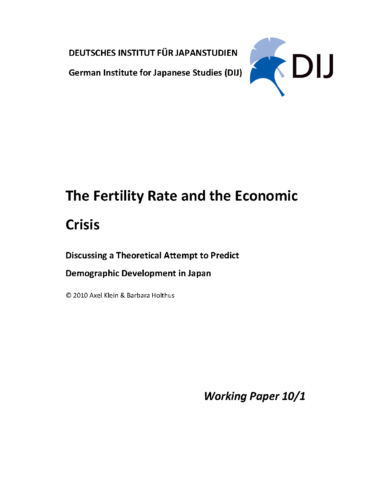
Download
Details
2010, Deutsches Institut für Japanstudien, Tokyo, 35 p.Authors
Holthus, Barbara
The Fertility Rate and the Economic Crisis - Discussing a Theoretical Attempt to Predict Demographic Development in Japan

The economic crisis, triggered in the US in the fall of 2008, quickly turned into a global affair that took over the top spot on the political agenda of all industrialized countries. Even though the first shock wave has ebbed away, mass media, politicians and academia have continued analyzing and discussing consequences for banks and financial systems, industries, labor market and employees. With these topics drawing a huge share of public attention, naturally others have remained unattended to, irrespective of their significance for society. The question of how Japan’s low total fertility rate will be affected, for example, is rarely addressed. This issue, however, is no doubt important as it deals with the impact of one significant crisis onto another.
To predict the impact of the economic crisis onto Japan’s fertility rate development, one needs adequate tools. Yet research until now has mostly been concerned with the causes that led to the fertility rate’s significant decline since the mid-1970s, such as late and less marriages, rising opportunity costs for women, and rising educational costs for children (Yamagami 1999, Goodman 2002, Shigeno and Matsuura 2003, Nagase 2005, Ogawa et al. 2006, Date and Shimizutani 2007, Rosenbluth 2007, Naohiro 2008).
However, a different approach can be found in the so-called “Low Fertility Trap Hypothesis” (LFTH), an empirically testable tool for the prediction of fertility development in low fertility countries in general, developed by demographers Lutz, Skirbekk, and Testa (2006). It is based on McDonald’s (2005) idea that fertility can decline to a degree at which it falls into a “trap” from which it cannot escape, meaning that once the TFR has fallen below said crucial point, a number of self-reinforcing mechanisms are possibly strengthened to a degree that fertility will not be able to leave the trap again.
In this Working Paper, we first apply this “Low Fertility Trap Hypothesis” to the case of Japan. We conduct this step by step for each of the three mechanisms. Through the application, we find the explanatory power of the hypothesis however too limited, thus suggesting the need to complement the LFTH by additional elements. In the second part of this paper, we therefore put forward a fourth mechanism, education, which we believe explains more precisely and to a greater extend Japan’s fertility development. Based on this, we attempt to show how Japan’s fertility will develop under the influence of the current economic crisis and conclude with a long term perspective also based on the LFTH.